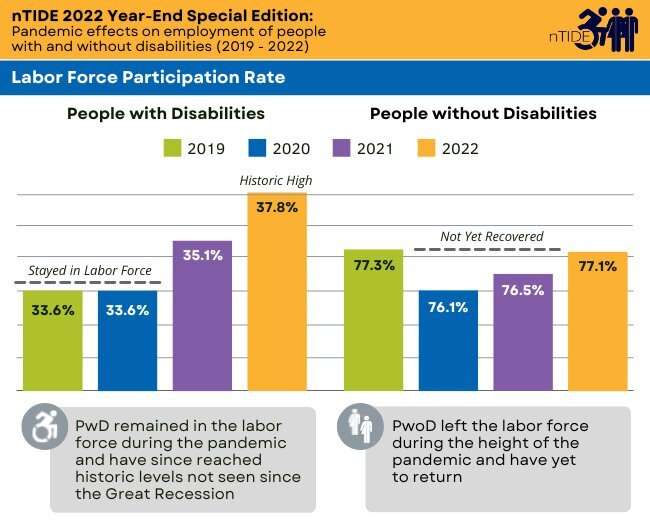The 2019 – 2022 data chart shows people with disabilities not only recovered from the setbacks of the 2020 COVID-19 lockdown but rebounded in 2021 and exceeded historic employment levels in 2022. Credit: Kessler Foundation
The year 2022 was a remarkable and historic time for the employment of people with disabilities. That's according to the National Trends in Disability Employment (nTIDE) 2022 Year-End Special Edition, issued by Kessler Foundation and the University of New Hampshire's Institute on Disability (UNH-IOD), based on data from the U.S. Bureau of Labor Statistics (BLS) Jobs Reports.
Employment trends in 2022 built upon the 2021 recovery from the pandemic recession—where people with disabilities reached beyond pre-COVID-19 levels and even pre-Great Recession levels. These trends are in stark contrast to those of their working counterparts without disabilities who have not yet reached pre-pandemic levels.
The average monthly employment-to-population ratio for people with disabilities (ages 16-64) increased from 31.3 percent in 2021 to 34.8 percent in 2022, which was also higher than the 29.1 percent recorded in 2020 (during the height of the pandemic) and 30.9 percent recorded in 2019 (prior to the pandemic).
In contrast, for people without disabilities (ages 16-64), the employment-to-population ratio increased from 72.5 percent in 2021 to 74.4 percent in 2022, which was higher than the 70.0 percent recorded in 2020 but not above the 74.6 percent in 2019. The employment-to-population ratio, a key indicator, reflects the percentage of people who are working relative to the total population (the number of people working divided by the number of people in the total population multiplied by 100).
"Labor shortages across the country mean that there was a disproportionate demand for workers compared to the number of people willing to fill positions. Hiring managers may have needed to break outside of their comfort zones to consider different segments of workers," said nTIDE co-author John O'Neill, Ph.D., director, Center for Employment and Disability Research, Kessler Foundation. "This likely led to a boon for people with disabilities looking for jobs and becoming employed," added Dr. O'Neill.
Findings were similar for 2022's labor force participation rate. For people with disabilities (ages 16-64), the labor force participation rate was increased from 35.1 percent in 2021 to 37.8 percent in 2022, which was also higher than the 33.6 percent posted in 2019 and 2020 when people with disabilities remained in the labor force during the height of the pandemic.
For people without disabilities (ages 16-64), the labor force participation rate was increased slightly from 76.5 percent in 2021 to 77.1 percent in 2022, both above the 76.1 percent posted during the height of the pandemic but not above the pre-pandemic 77.3 percent posted in 2019. The labor force participation rate, another key indicator, reflects the percentage of people who are working, looking for work, or on temporary layoff relative to the total population (the number of people participating in the labor force divided by the number of people in the total population multiplied by 100).
"People with disabilities are not participating in the Great Resignation, unlike their counterparts without disabilities. In fact, people with disabilities never left the labor force during the pandemic," explained nTIDE co-author Andrew Houtenville, Ph.D., professor of economics and research director at the UNH-IOD. "The increase in work-from-home arrangements and greater flexibility in work hours seen during the height of the pandemic may have permanently opened new employment opportunities for people with disabilities," added Dr. Houtenville.
Changes to more flexible work arrangements were confirmed by the findings of the 2022 National Employment & Disability Survey: Effects of COVID-19 Pandemic on Supervisor Perspectives conducted by Kessler Foundation and UNH. In addition, hiring and recruiting people with disabilities was more important to supervisors and upper management in 2022 than in 2017, when compared to the findings of the 2017 National Employment & Disability Survey: Supervisor Perspectives.
The use of flexible work arrangements more than doubled from 2017, with most supervisors predicting that work-from-home options would continue post-pandemic. And today, twice as many supervisors work for organizations with a central accommodation fund, which supervisors view as important to the success of people with disabilities in the workplace.
Hiring and recruiting people with disabilities was more important to supervisors and upper management in 2022, and more organizations had established hiring goals than in 2017. "Today, more companies are partnering with disability organizations in their recruitment efforts," said Dr. O'Neill, Ph.D., adding, "And more are using outside assistance for onboarding workers with disabilities. We also see more employers adopting training on disability issues and cultural competence in 2022 and reaching out to government and local resources regarding the provision of accommodations."
Connection to growing inflation in 2022
In March 2022, the Federal Reserve began trying to slow the economy to control inflation by raising interest rates. The Fed continued to raise interest rates an additional four times through September 2022. "Growing inflation rates and rising costs for goods and services almost certainly spurred families to find extra income," said Dr. Houtenville.
"People with disabilities must strive to meet their families' needs and their own, especially since at least 25 percent live below the poverty level," he stated, citing the UNH 2021 Annual Report on People with Disabilities in America. "There was an interplay of necessity and demand: people with disabilities needed employment dollars and employers needed employees to fill their gaps. These factors provided a welcomed opportunity for people with disabilities," added Dr. Houtenville.
Because of the large employment gap between people with and without disabilities, Dr. O'Neill wants to see people with disabilities maintain the gains of the past four years, stating: "We must continue to support the uphill advances achieved by workers with disabilities even as people without disabilities decide to return to the labor force. Collaborative efforts by stakeholders such as advocates, workers, employers, and vocational rehabilitation professionals will help continue the momentum and keep us on course."
More information: Report: kesslerfoundation.org/employme … ectives-KFSurvey2022
Provided by Kessler Foundation
























